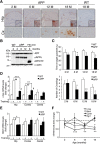Crtc1 activates a transcriptional program deregulated at early Alzheimer's disease-related stages
- PMID: 24760838
- PMCID: PMC6608295
- DOI: 10.1523/JNEUROSCI.5288-13.2014
Crtc1 activates a transcriptional program deregulated at early Alzheimer's disease-related stages
Abstract
Cognitive decline is associated with gene expression changes in the brain, but the transcriptional mechanisms underlying memory impairments in cognitive disorders, such as Alzheimer's disease (AD), are largely unknown. Here, we aimed to elucidate relevant mechanisms responsible for transcriptional changes underlying early memory loss in AD by examining pathological, behavioral, and transcriptomic changes in control and mutant β-amyloid precursor protein (APPSw,Ind) transgenic mice during aging. Genome-wide transcriptome analysis using mouse microarrays revealed deregulation of a gene network related with neurotransmission, synaptic plasticity, and learning/memory in the hippocampus of APPSw,Ind mice after spatial memory training. Specifically, APPSw,Ind mice show changes on a cAMP-responsive element binding protein (CREB)-regulated transcriptional program dependent on the CREB-regulated transcription coactivator-1 (Crtc1). Interestingly, synaptic activity and spatial memory induces Crtc1 dephosphorylation (Ser151), nuclear translocation, and Crtc1-dependent transcription in the hippocampus, and these events are impaired in APPSw,Ind mice at early pathological and cognitive decline stages. CRTC1-dependent genes and CRTC1 levels are reduced in human hippocampus at intermediate Braak III/IV pathological stages. Importantly, adeno-associated viral-mediated Crtc1 overexpression in the hippocampus efficiently reverses Aβ-induced spatial learning and memory deficits by restoring a specific subset of Crtc1 target genes. Our results reveal a critical role of Crtc1-dependent transcription on spatial memory formation and provide the first evidence that targeting brain transcriptome reverses memory loss in AD.
Keywords: CREB; TORC; gene expression; memory; neurodegeneration; β-amyloid.
Figures





Similar articles
-
beta-Amyloid disrupts activity-dependent gene transcription required for memory through the CREB coactivator CRTC1.J Neurosci. 2010 Jul 14;30(28):9402-10. doi: 10.1523/JNEUROSCI.2154-10.2010. J Neurosci. 2010. PMID: 20631169 Free PMC article.
-
CREB-regulated transcription coactivator 1-dependent transcription in Alzheimer's disease mice.Neurodegener Dis. 2012;10(1-4):250-2. doi: 10.1159/000333341. Epub 2012 Jan 6. Neurodegener Dis. 2012. PMID: 22236576
-
CRTC1 Function During Memory Encoding Is Disrupted in Neurodegeneration.Biol Psychiatry. 2017 Jan 15;81(2):111-123. doi: 10.1016/j.biopsych.2016.06.025. Epub 2016 Jul 11. Biol Psychiatry. 2017. PMID: 27587263
-
Gene expression parallels synaptic excitability and plasticity changes in Alzheimer's disease.Front Cell Neurosci. 2015 Aug 25;9:318. doi: 10.3389/fncel.2015.00318. eCollection 2015. Front Cell Neurosci. 2015. PMID: 26379494 Free PMC article. Review.
-
Memory-related process in physiological status and alzheimer's disease.Mol Biol Rep. 2020 Jun;47(6):4651-4657. doi: 10.1007/s11033-020-05438-y. Epub 2020 Apr 11. Mol Biol Rep. 2020. PMID: 32279208 Review.
Cited by
-
Identification of Differentially Expressed Genes through Integrated Study of Alzheimer's Disease Affected Brain Regions.PLoS One. 2016 Apr 6;11(4):e0152342. doi: 10.1371/journal.pone.0152342. eCollection 2016. PLoS One. 2016. PMID: 27050411 Free PMC article.
-
New Insights Into the Pivotal Role of CREB-Regulated Transcription Coactivator 1 in Depression and Comorbid Obesity.Front Mol Neurosci. 2022 Feb 15;15:810641. doi: 10.3389/fnmol.2022.810641. eCollection 2022. Front Mol Neurosci. 2022. PMID: 35242012 Free PMC article. Review.
-
Epigenetic regulation of Fgf1 transcription by CRTC1 and memory enhancement.Brain Res Bull. 2018 Jul;141:3-12. doi: 10.1016/j.brainresbull.2018.02.016. Epub 2018 Mar 2. Brain Res Bull. 2018. PMID: 29477835 Free PMC article. Review.
-
A selective inhibitor of histone deacetylase 3 prevents cognitive deficits and suppresses striatal CAG repeat expansions in Huntington's disease mice.Sci Rep. 2017 Jul 20;7(1):6082. doi: 10.1038/s41598-017-05125-2. Sci Rep. 2017. PMID: 28729730 Free PMC article.
-
BACE1 inhibition by microdose lithium formulation NP03 rescues memory loss and early stage amyloid neuropathology.Transl Psychiatry. 2017 Aug 1;7(8):e1190. doi: 10.1038/tp.2017.169. Transl Psychiatry. 2017. PMID: 28763060 Free PMC article.
References
-
- Benjamini Y, Hochberg Y. Controlling the false discovery rate: a practical and powerful approach to multiple testing. J R Stat Soc Ser B. 1995;57:289–300.
-
- Bindea G, Mlecnik B, Hackl H, Charoentong P, Tosolini M, Kirilovsky A, Fridman WH, Pagès F, Trajanoski Z, Galon J. ClueGO: a cytoscape plug-in to decipher functionally grouped gene ontology and pathway annotation networks. Bioinformatics. 2009;25:1091–1093. doi: 10.1093/bioinformatics/btp101. - DOI - PMC - PubMed
Publication types
MeSH terms
Substances
LinkOut - more resources
Full Text Sources
Other Literature Sources
Medical
Molecular Biology Databases
